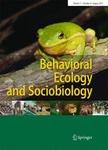版权所有:内蒙古大学图书馆 技术提供:维普资讯• 智图
内蒙古自治区呼和浩特市赛罕区大学西街235号 邮编: 010021

作者机构:Chinese Acad Sci Inst Zool Key Lab Anim Ecol & Conservat Biol Beijing 100101 Peoples R China Chinese Acad Sci Grad Univ Beijing 100039 Peoples R China San Diego Zoo Inst Conservat Res San Diego CA 92112 USA China W Normal Univ Inst Rare Animals & Plants Nanchong 637002 Sichuan Peoples R China Foping Natl Nat Reserve Foping 723400 Shaanxi Peoples R China
出 版 物:《BEHAVIORAL ECOLOGY AND SOCIOBIOLOGY》 (行为生态学与社会生物学)
年 卷 期:2012年第66卷第5期
页 面:721-730页
核心收录:
学科分类:0402[教育学-心理学(可授教育学、理学学位)] 0710[理学-生物学] 07[理学] 09[农学] 0713[理学-生态学]
基 金:Foping National Nature Reserve National Natural Science Foundation of China Chinese Academy of Sciences [KSCX2-EW-Z-4, CZBZX-1] San Diego Zoo Global
主 题:Giant panda Reproductive behavior Fecal testosterone Aggression Competition Challenge hypothesis
摘 要:The giant panda (Ailuropoda melanoleuca) is notoriously difficult to study in the wild, but its interesting reproductive ecology makes the effort worthwhile. Perhaps more than most species, the panda is energy-limited, which alters the cost/benefit analysis of its reproductive ecology. Using global positioning system/very high frequency radiocollars to locate mating aggregations, we used behavioral observations and fecal testosterone assays to gain insight into male panda reproductive effort and strategies, and test theories relating to reproductive competition. Male pandas initially competed fiercely for access to females that were about to be fertile, but once male competitive status was determined, aggression rates declined. Contact aggression was only observed during the first 2 days of mating aggregations;thereafter, it was replaced with noncontact aggression and avoidance. Agonistic interactions were highly asymmetrical, with contest losers (subordinates) showing less aggression and more avoidance than contest winners (dominants), both before and after contest outcome was established. The competitively superior male displayed mate-guarding tactics and secured all observed copulations. Contrary to theoretical predictions, testosterone levels did not predict aggression levels or contest winners and also were not affected by winning or losing a contest. Body size appeared to be the primary determinant of contest outcome. We discuss our findings in light of theoretical predictions, such as those arising from the challenge hypothesis, in the context of the giant panda s foraging and nutritional ecology.